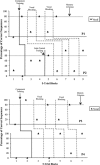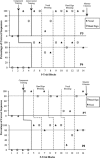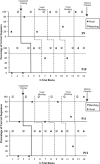The Effects of Blocking and Joint Control Training on Sequencing Visual Stimuli
- PMID: 30800629
- PMCID: PMC6381339
- DOI: 10.1007/s40616-016-0067-1
The Effects of Blocking and Joint Control Training on Sequencing Visual Stimuli
Abstract
We assessed the effects of blocking on the accuracy of arranging visual stimuli in sequences as an attempt to assess whether verbal behavior mediates nonverbal performance. Across three experiments, college students were trained to echo and tact the names of abstract images vocally (Experiments 1 and 3) and with hand signs (Experiment 2), and then, they were tested to see whether they could sequence these pictures accurately in the presence of their dictated names or signs. When participants were required to engage in a vocal blocking task, sequencing performances learned via either vocal or hand signs deteriorated (Experiments 1 and 2). In Experiment 3, vocal blocking deteriorated sequencing learned vocally, but not when participants were responding to visual samples (i.e., visual matching). Overall, only 2 out of 12 participants required joint control training to accurately sequence stimuli. Combined results suggest that vocal blocking may serve to prevent verbal behavior that could be mediating sequencing, and that joint control training is not necessary for adults to perform the sequencing task.
Keywords: Blocking; Echoic; Joint control; Tact; Verbal behavior.
Conflict of interest statement
The authors declare that they have no conflict of interest.All procedures performed in studies involving human participants were in accordance with the ethical standards of the Human Subjects Institutional Review Board at California State University, Sacramento and with the 1964 Helsinki declaration and its later amendments or comparable ethical standards.Informed consent was obtained for all individual participants included in the study. Participants could leave the study at any time, and assent was obtained at each session with participants who could leave at any time.
Figures




Similar articles
-
The Effects of Competing Verbal Behavior on Performance in a Math Task.Anal Verbal Behav. 2021 Jun 22;37(1):57-76. doi: 10.1007/s40616-021-00145-6. eCollection 2021 Jun. Anal Verbal Behav. 2021. PMID: 34395166 Free PMC article.
-
The Effects of Vocal Blocking on Sequencing Visual and Tactile Stimuli.Anal Verbal Behav. 2023 Jun 29;39(2):226-246. doi: 10.1007/s40616-023-00187-y. eCollection 2023 Dec. Anal Verbal Behav. 2023. PMID: 38075502 Free PMC article.
-
Emergence of visual-visual conditional discriminations.J Exp Anal Behav. 2015 Mar;103(2):332-48. doi: 10.1002/jeab.136. Epub 2015 Feb 4. J Exp Anal Behav. 2015. PMID: 25649198
-
Establishing equivalence-equivalence analogical relations via tact and listener training.J Exp Anal Behav. 2021 Jan;115(1):340-360. doi: 10.1002/jeab.652. Epub 2020 Dec 14. J Exp Anal Behav. 2021. PMID: 33319373
-
Training Intraverbal Naming to Establish Matching-to-Sample Performances.Anal Verbal Behav. 2015 Sep 29;31(2):162-82. doi: 10.1007/s40616-015-0040-4. eCollection 2015 Oct. Anal Verbal Behav. 2015. PMID: 27606210 Free PMC article.
Cited by
-
Intraverbal Assessment for Persons with Aphasia or Other Acquired Brain Injury.Anal Verbal Behav. 2023 Jan 25;39(1):30-59. doi: 10.1007/s40616-022-00180-x. eCollection 2023 Jun. Anal Verbal Behav. 2023. PMID: 37397130 Free PMC article.
-
The Effects of Competing Verbal Behavior on Performance in a Math Task.Anal Verbal Behav. 2021 Jun 22;37(1):57-76. doi: 10.1007/s40616-021-00145-6. eCollection 2021 Jun. Anal Verbal Behav. 2021. PMID: 34395166 Free PMC article.
-
The Effect of Joint Control Training on the Performance of Multiply Controlled Behavior: A Systematic Literature Review Relevant to Children With Autism Spectrum Disorder and Other Developmental Disabilities.Anal Verbal Behav. 2019 Aug 29;35(2):149-171. doi: 10.1007/s40616-019-00116-y. eCollection 2019 Dec. Anal Verbal Behav. 2019. PMID: 31976228 Free PMC article.
-
The Effects of Reinforcing Tacting on the Recall of Children with Autism.Anal Verbal Behav. 2024 Jun 27;41(1):1-10. doi: 10.1007/s40616-024-00207-5. eCollection 2025 Jun. Anal Verbal Behav. 2024. PMID: 40708963 Free PMC article.
-
Common and Intraverbal Bidirectional Naming.Anal Verbal Behav. 2016 Oct 25;32(2):125-138. doi: 10.1007/s40616-016-0066-2. eCollection 2016 Oct. Anal Verbal Behav. 2016. PMID: 30800621 Free PMC article.
References
-
- Causin KG, Albert KM, Carbone VJ, Sweeney-Kerwin EJ. The role of joint control in teaching listener responding to children with autism and other developmental disabilities. Research in Autism Spectrum Disorders. 2013;7:997–1011. doi: 10.1016/j.rasd.2013.04.011. - DOI
LinkOut - more resources
Full Text Sources

